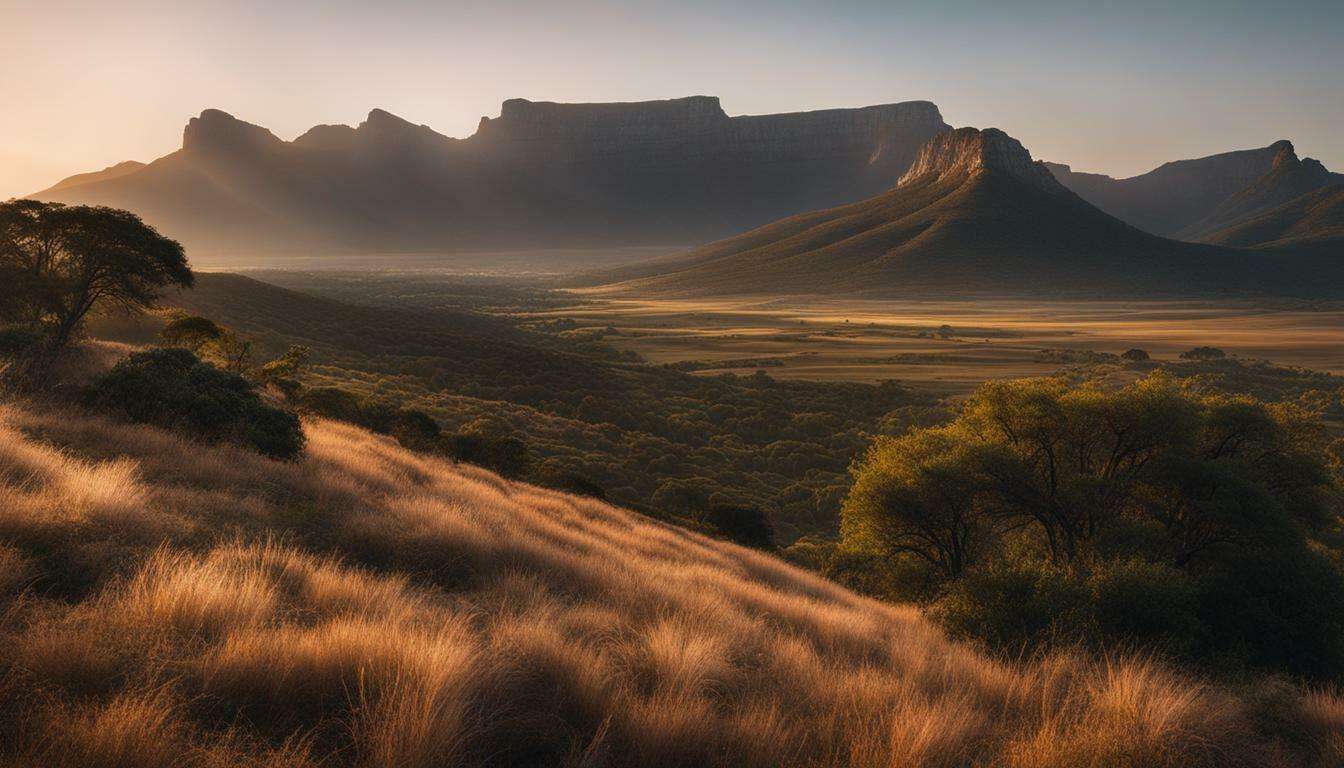Natural light plays a crucial role in photography, and understanding its variations is essential for capturing stunning images. Natural light refers to any light source created by the sun and can be utilized both indoors and outdoors. It possesses distinct characteristics, including intensity, color temperature, direction, and quality, all of which greatly impact the final result of a photograph.
Key Takeaways:
- Natural light is a vital element in photography, and its variations must be comprehended for successful image capturing.
- Characteristics such as intensity, color temperature, direction, and quality shape the nature of natural light.
- The intensity of natural light varies throughout the day and is influenced by weather conditions.
- Color temperature changes with different times of the day and can be influenced by atmospheric conditions.
- The direction of natural light impacts how it interacts with the subject, making it crucial to consider when photographing portraits or other subjects.
Characteristics of Natural Light
Natural light possesses unique characteristics that photographers need to consider when capturing their subjects. These characteristics include intensity, color temperature, direction, and quality. The intensity of natural light varies throughout the day, with softer lighting during the golden hour and harsher lighting during midday. It is important for photographers to understand how the intensity of natural light can affect the mood and atmosphere of their photographs.
The color temperature of natural light also changes throughout the day, ranging from cooler tones in the morning and evening to warmer tones during midday. This variation in color temperature can create different effects and moods in photographs. For example, warmer tones can evoke a sense of warmth and comfort, while cooler tones can create a more serene and tranquil atmosphere.
The direction of natural light is another crucial factor to consider. The way light hits the subject can greatly impact the shadows and highlights in the image. For portrait photography, it is important to position the subject in relation to the direction of light to achieve the desired effect. Side lighting can create dramatic shadows, while front lighting can provide a more evenly lit and flattering result.
The quality of natural light can be either hard or soft. Hard light produces well-defined and strong shadows, while soft light creates subtle and diffused shadows. The quality of light can be influenced by factors such as cloud cover or the use of reflectors and diffusers. Photographers can experiment with different qualities of natural light to achieve the desired look and feel for their images.
| Type | Description |
|---|---|
| Intensity | Varies throughout the day, with softer lighting during golden hour and harsher lighting at midday. |
| Color Temperature | Changes from cooler tones in the morning and evening to warmer tones during midday. |
| Direction | Affects the way light hits the subject, creating different shadows and highlights. |
| Quality | Can be hard or soft, producing well-defined or diffused shadows respectively. |
Understanding the characteristics of natural light is essential for photographers, as it allows them to make informed decisions about exposure, composition, and lighting techniques. By harnessing the unique qualities of natural light, photographers can create stunning and evocative images that captivate viewers.
Advantages and Drawbacks of Natural Light
Utilizing natural light in photography offers numerous benefits and challenges that photographers should be aware of. Understanding the advantages and drawbacks of natural light is essential for capturing stunning images. One of the main advantages of natural light is its low cost. Unlike artificial lighting, which requires expensive equipment and setup, natural light is freely available. This makes it an accessible option for photographers of all levels.
Natural light also provides a wide variety of lighting conditions, allowing photographers to experiment with different styles and moods. From the soft and warm light during golden hour to the dramatic shadows created by harsh sunlight, natural light offers endless possibilities for creative expression. Additionally, the convenience of natural light cannot be overlooked. Whether shooting outdoors or utilizing it to illuminate indoor spaces, natural light provides a flexible and readily available light source.
However, it is important to consider the drawbacks of natural light as well. One of the main challenges is its volatility. Unlike artificial lighting, which can be controlled and manipulated to suit specific needs, natural light is unpredictable. It can change rapidly due to weather conditions, cloud cover, and the position of the sun. This variability can make it difficult to achieve consistent lighting throughout a shoot, requiring photographers to adapt quickly and make adjustments.
Another drawback is the limited control over intensity with natural light. Unlike artificial lighting, which can be adjusted to any desired brightness, natural light is dependent on external factors. While photographers can use reflectors and diffusers to modify natural light to some extent, they have less control over its overall intensity. This can be challenging when shooting in scenarios that require precise exposure and lighting control.
| Advantages of Natural Light | Drawbacks of Natural Light |
|---|---|
| Low cost | Volatility |
| Variety of lighting conditions | Limited control over intensity |
| Convenience |
In conclusion, natural light offers numerous advantages and drawbacks for photographers. While it provides low cost, variety, and convenience, it also presents challenges such as volatility and limited control over intensity. To make the most of natural light, photographers should embrace its unique qualities, adapt to changing conditions, and utilize techniques such as reflectors to enhance their images. By understanding the characteristics and behaviors of natural light, photographers can capture stunning photographs that showcase the beauty of the world around them.
Types of Natural Light Sources
Different types of natural light sources offer photographers diverse opportunities for capturing stunning photos. Understanding the characteristics and behaviors of each type can greatly enhance the quality of your images. Here are the main types of natural light sources:
1. Direct sunlight
Direct sunlight is the most intense type of natural light. It produces sharp, well-defined shadows and vibrant colors, making it ideal for creating dramatic and high-contrast images. However, shooting under direct sunlight can be challenging due to the harsh and potentially unflattering lighting conditions. It is important to consider the angle and position of the sun to maximize the desired effect.
2. Diffused light
Diffused light is softer and more evenly distributed than direct sunlight. It occurs when the sunlight is scattered or filtered through clouds, fog, or other translucent objects. This type of light produces softer shadows and reduces the contrast in the scene, resulting in a more flattering and even lighting effect. Diffused light is particularly well-suited for portrait photography, as it helps to minimize imperfections and bring out the natural beauty of the subject.
3. Reflected light
Reflected light occurs when sunlight bounces off surfaces such as water, buildings, or even the ground. This type of light can create interesting and unique lighting effects, depending on the reflective surface and its proximity to the subject. For example, shooting near a body of water can produce a beautiful luminous glow, while shooting in an urban environment with reflective surfaces can create striking reflections and highlights. Experimenting with different angles and compositions can yield stunning results when working with reflected light.
| Type | Characteristics | Best Use |
|---|---|---|
| Direct sunlight | Intense, sharp shadows, vibrant colors | Dramatic and high-contrast images |
| Diffused light | Soft, even lighting, reduced contrast | Portrait photography, minimizing imperfections |
| Reflected light | Unique lighting effects, striking reflections | Experimentation with angles and compositions |
Each type of natural light source offers its own advantages and challenges. By understanding how these variations in lighting behave and utilizing them effectively, photographers can elevate their images to new heights.
Tips for Working with Natural Light
Mastering the art of working with natural light requires implementing effective techniques and strategies. The characteristics of natural light, such as intensity, color temperature, direction, and quality, can greatly impact the outcome of your photographs. To make the most of natural light, here are some photography tips to consider:
- Shoot during the golden hour: The golden hour is the period shortly after sunrise or before sunset when the sun is low on the horizon, creating a warm and soft light. This magical time offers beautiful, golden tones and long, flattering shadows. Plan your outdoor shoots around this time for stunning results.
- Utilize weather conditions: Don’t let unfavorable weather discourage you from shooting outdoors. Rainy or cloudy days can provide a unique and moody lighting atmosphere. Experiment with capturing reflections on wet surfaces or embracing the soft, diffused light on overcast days. Remember to protect your gear from the elements.
- Use reflectors: Reflectors are versatile tools that can help control and enhance natural light. They bounce light back onto the subject, filling in shadows and adding natural-looking highlights. Silver reflectors provide a crisp, cool light, while gold reflectors produce a warm, sun-kissed glow. Explore different sizes and shapes to achieve the desired effect.
- Adjust your camera settings: Understanding how to adjust your camera settings is crucial when working with natural light. Experiment with different exposure settings, such as aperture, shutter speed, and ISO, to achieve the desired brightness and mood in your photographs. Bracketing exposures can also be useful to capture a range of lighting conditions.
Remember, each shooting situation is unique, so practice and experimentation are key to mastering natural light photography. Pay attention to the direction and quality of the light, as well as the time of day, to create stunning images that capture the true essence of your subject.
| Photography Tips for Working with Natural Light | Summary |
|---|---|
| Shoot during the golden hour | Captures warm, soft light and long shadows |
| Utilize weather conditions | Embrace rainy or cloudy days for unique atmospheres |
| Use reflectors | Control and enhance natural light with silver or gold reflectors |
| Adjust camera settings | Experiment with exposure settings to achieve desired brightness and mood |
Natural Light Variations in South Africa’s Diverse Landscapes
South Africa’s diverse landscapes offer photographers a wide range of natural light variations to explore and capture. From the arid plains of the Karoo to the lush forests of the Garden Route, each region presents unique lighting opportunities that can elevate the beauty and impact of photographs.
In the iconic Kruger National Park, for example, the golden hues of sunrise and sunset cast a warm, ethereal glow over the savannah, creating a magical atmosphere. The table below showcases the best times of day to capture these stunning moments:
| Time of Day | Lighting Conditions |
|---|---|
| Morning | Soft, diffused light with warm tones |
| Midday | Harsh and intense light, creating strong shadows |
| Afternoon | Golden hour light with warm, soft tones |
On the other hand, the dramatic Drakensberg Mountains offer a different kind of natural light spectacle. The shifting patterns of light and shadow over the rugged peaks and valleys create a dynamic landscape that demands photographers’ attention. The following quote captures this essence:
“The interplay of light and shadow in the Drakensberg Mountains is a photographer’s dream. From dawn to dusk, the changing light reveals the intricate details of the towering cliffs and plunging waterfalls, adding depth and drama to every frame.”
When exploring the coastal regions of South Africa, such as the Cape Peninsula, photographers encounter a whole new set of natural light variations. The ever-changing weather conditions, including misty mornings and stormy skies, offer endless opportunities for capturing moody and atmospheric shots. The following table summarizes the key characteristics of coastal lighting:
| Lighting Condition | Effect |
|---|---|
| Misty mornings | Soft, diffused light with a serene and mystical ambiance |
| Clear skies | Bright and vibrant light that illuminates the coastal landscapes |
| Stormy weather | Dramatic and dynamic lighting, enhancing the power of the ocean |
South Africa’s diverse landscapes provide photographers with an incredible canvas for capturing the beauty of natural light. Whether it’s the golden hues of the savannah, the interplay of light and shadow in the mountains, or the atmospheric lighting of the coastal regions, each location offers a unique and captivating experience for photographers seeking to create stunning images.
Importance of Understanding Natural Light Variations for Photography in South Africa
Photographers in South Africa can elevate their craft by mastering the understanding of natural light variations specific to the region. South Africa’s diverse landscapes offer a wide range of lighting conditions, each with its own unique characteristics and challenges. Whether capturing the golden hues of the savannah, the dramatic coastal scenery, or the vibrant colors of the urban landscapes, being able to adapt to the changing natural light is crucial for achieving exceptional photography results.
In South Africa, the quality and intensity of natural light can vary greatly depending on factors such as geographical location, elevation, and weather conditions. The harsh midday sun in the arid regions can create strong shadows and lead to overexposure, while the soft morning and evening light can enhance the beauty of landscapes and portraits. By understanding these variations, photographers can make informed decisions on the best time and location to shoot, ensuring they capture the essence and mood of the scene.
One of the key benefits of working with natural light in South Africa is the incredible variety it offers. From the vibrant sunrise over Table Mountain to the golden hour in Kruger National Park, the changing light throughout the day presents endless opportunities for creative compositions. By embracing these variations, photographers can add depth, dimension, and a sense of realism to their images that would be hard to replicate with artificial lighting.
However, it’s important to acknowledge the limitations of natural light and the need for adaptability. Unlike artificial lighting, natural light is unpredictable and can change rapidly. Photographers must be prepared to adjust their camera settings, composition, and shooting techniques to make the most of the available light. Utilizing tools such as reflectors or diffusers can also help control the intensity and direction of natural light, allowing photographers to create the desired effects in their images.
| Key Points: | Tips for photographing in South Africa: |
|---|---|
| 1. Understand the changing natural light conditions in different regions. | – Research the best time of day for capturing specific landscapes. |
| 2. Embrace the variety of natural light for creative compositions. | – Experiment with different angles and perspectives to capture unique lighting. |
| 3. Be flexible and adaptable to quickly adjust camera settings. | – Use exposure compensation to balance light and shadows. |
| 4. Utilize tools like reflectors or diffusers for better control. | – Carry a portable reflector to fill in shadows or soften harsh light. |
| 5. Practice patience and be prepared to wait for the perfect moment. | – Observe the changing light and anticipate how it will transform the scene. |
Photography in South Africa presents a wealth of opportunities to capture stunning images, and understanding natural light variations is key to unlocking its full potential. By mastering the nuances of natural light and being adaptable to the changing conditions, photographers can create truly extraordinary and evocative photographs that capture the essence of this beautiful country.
Conclusion
Understanding natural light and its variations is a fundamental aspect of photography that can greatly enhance the quality of your images. Natural light, created by the sun, is a versatile light source that can be used both indoors and outdoors. It possesses unique characteristics such as intensity, color temperature, direction, and quality, which play a significant role in capturing stunning photographs.
The intensity of natural light varies throughout the day and is influenced by weather conditions, creating different moods and effects. The color temperature of natural light changes as the sun moves across the sky, providing warm tones during sunrise and sunset. The direction of natural light determines how it interacts with the subject, making it crucial to consider when shooting portraits or landscapes.
While natural light offers many advantages, including being cost-effective, diverse, and easily accessible, it also presents some challenges. Natural light can be unpredictable due to its volatility and the limitations in controlling its intensity. However, by understanding and working with natural light, photographers can achieve remarkable results.
To make the most of natural light, photographers can implement various techniques. Shooting during the golden hour, the period shortly after sunrise or before sunset, can create a soft, warm glow. Utilizing the weather conditions, such as clouds or snow, can add depth and texture to your images. Reflectors can be used to manipulate and enhance the lighting, providing more control over the final outcome.
By familiarizing themselves with the different types of natural light sources and behaviors, photographers can adapt and optimize their techniques accordingly. South Africa, with its diverse landscapes and unique lighting variations, offers a wealth of opportunities for photographers. Understanding the nuances of natural light in South Africa can elevate your photography to new heights.
In conclusion, grasping the intricacies of natural light and its variations is essential for photographers who strive to capture stunning images. By harnessing the power of natural light, photographers can unlock their creative potential and produce remarkable photographs that tell captivating stories.
How Can I Adjust My Shooting Techniques for Different Lighting Conditions?
Adjusting shooting techniques for shooting in various lighting conditions can greatly enhance the quality of your photographs. In bright outdoor lighting, using a smaller aperture and faster shutter speed can prevent overexposure. In low-light situations, increasing ISO and using a wider aperture can help capture more light. Experimenting and adapting your settings to each lighting condition will enable you to capture stunning photos in any situation.
How Can Understanding Natural Light Benefit Videography Skills?
Understanding natural light is crucial for videographers to enhance their skills and capture breathtaking shots. The value of videography skills lies in the ability to manipulate light and utilize its effects on the subject. Mastering the intricacies of natural light allows videographers to create visually stunning videos, adding depth, mood, and overall impact to their work. Harnessing this knowledge paves the way for truly immersive storytelling and captivating visuals.
FAQ
What is natural light?
Natural light refers to any light source created by the sun and can be used both indoors and outdoors.
What are the key characteristics of natural light?
Natural light has different characteristics, including intensity, color temperature, direction, and quality.
How does the intensity of natural light vary?
The intensity of natural light varies depending on the time of day and weather conditions.
Does the color temperature of natural light change?
Yes, the color temperature of natural light changes throughout the day and can be affected by clouds and snow.
What role does the direction of natural light play in photography?
The direction of natural light affects the way it hits the subject, making it important to consider when shooting portraits.
Is natural light always of the same quality?
No, the quality of natural light can be either hard or soft, depending on the desired effect.
What are the advantages of using natural light in photography?
Natural light has several advantages, including being low cost, providing variety, and being convenient.
Are there any drawbacks to using natural light?
Yes, drawbacks of natural light include volatility and less control over intensity.
How can photographers work with natural light?
Photographers can work with natural light by using tips such as shooting during golden hour, utilizing the weather to their advantage, and using reflectors.
Why is it important to understand the different types of natural light sources?
Understanding the different types of natural light sources helps photographers achieve desired results by leveraging their behaviors.
How can South Africa’s diverse landscapes impact natural light variations?
South Africa’s diverse landscapes, regions, weather conditions, and times of the day can all impact the quality and characteristics of natural light.
Why is understanding natural light variations important for photography in South Africa?
Understanding natural light variations is important for photography in South Africa to adapt to changing lighting conditions, utilize different techniques for different landscapes, and maximize unique lighting opportunities.






